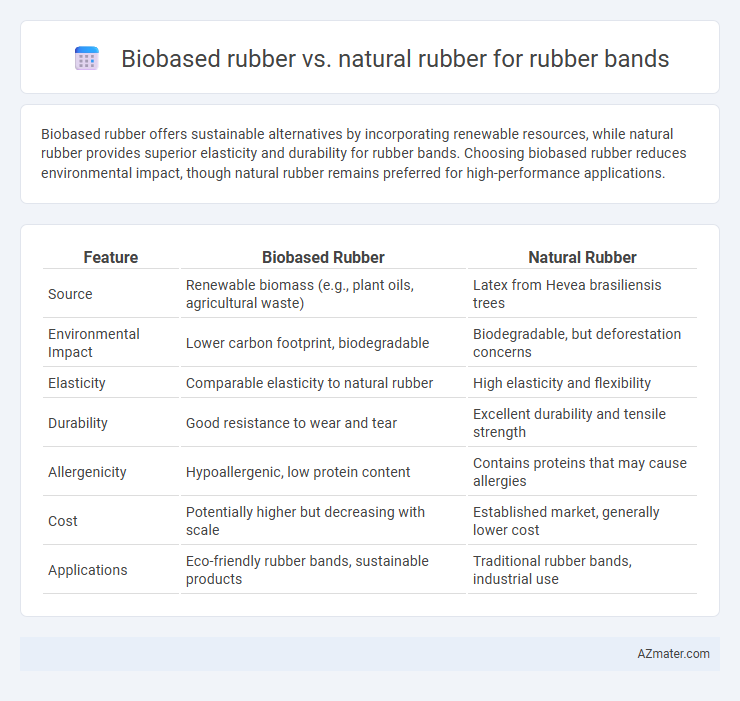Biobased rubber offers sustainable alternatives by incorporating renewable resources, while natural rubber provides superior elasticity and durability for rubber bands. Choosing biobased rubber reduces environmental impact, though natural rubber remains preferred for high-performance applications.
Table of Comparison
| Feature | Biobased Rubber | Natural Rubber |
|---|---|---|
| Source | Renewable biomass (e.g., plant oils, agricultural waste) | Latex from Hevea brasiliensis trees |
| Environmental Impact | Lower carbon footprint, biodegradable | Biodegradable, but deforestation concerns |
| Elasticity | Comparable elasticity to natural rubber | High elasticity and flexibility |
| Durability | Good resistance to wear and tear | Excellent durability and tensile strength |
| Allergenicity | Hypoallergenic, low protein content | Contains proteins that may cause allergies |
| Cost | Potentially higher but decreasing with scale | Established market, generally lower cost |
| Applications | Eco-friendly rubber bands, sustainable products | Traditional rubber bands, industrial use |
Introduction to Rubber Bands: Biobased vs Natural Rubber
Rubber bands are commonly made from natural rubber derived from the latex of rubber trees, valued for its elasticity and strength. Biobased rubber, produced from renewable plant materials such as guayule or dandelion rubber, offers an eco-friendly alternative with comparable mechanical properties. The shift towards biobased rubber aims to reduce dependence on traditional rubber plantations and enhance sustainability in rubber band manufacturing.
Defining Biobased Rubber and Natural Rubber
Biobased rubber is a sustainable elastomer derived from renewable plant materials such as guayule or dandelion, offering an eco-friendly alternative to traditional rubber products like rubber bands. Natural rubber, predominantly sourced from the latex of Hevea brasiliensis trees, is a highly elastic material widely used for its superior tensile strength and flexibility in rubber band manufacturing. While natural rubber relies on tree plantations, biobased rubber emphasizes renewable agricultural inputs, promoting reduced environmental impact and resource sustainability in rubber band production.
Raw Material Sources and Sustainability
Biobased rubber is derived from renewable biomass sources such as plant oils, starches, and natural polymers, offering a sustainable alternative to traditional natural rubber, which primarily comes from Hevea brasiliensis latex trees. The cultivation of biobased rubber feedstocks often requires less water, land, and energy, reducing environmental impact and deforestation concerns associated with natural rubber plantations. This shift toward biobased raw materials enhances the sustainability profile of rubber bands by minimizing reliance on fossil resources and promoting circular economy principles through biodegradable and eco-friendly production.
Manufacturing Processes: Biobased vs Natural Rubber
Biobased rubber for rubber bands is manufactured using sustainable feedstocks such as bioethanol-derived isoprene, which undergoes polymerization processes similar to traditional methods but with lower environmental impact. Natural rubber production involves tapping latex from Hevea brasiliensis trees, followed by coagulation and vulcanization, which can be labor-intensive and sensitive to ecological factors. Advanced biobased rubber manufacturing leverages biotechnology and chemical synthesis to create consistent polymer quality, enhancing scalability and reducing reliance on agricultural variables inherent in natural rubber harvesting.
Mechanical Properties and Performance Comparison
Biobased rubber, derived from renewable resources such as bio-synthetic polyisoprene, exhibits comparable tensile strength and elongation at break to natural rubber, which is harvested from Hevea brasiliensis latex. Both materials demonstrate excellent elasticity and resilience essential for rubber band applications, though biobased rubber often features enhanced aging resistance and improved thermal stability due to its tailored molecular structure. Mechanical properties such as Young's modulus and abrasion resistance are closely matched, making biobased rubber a sustainable alternative without compromising performance.
Environmental Impact and Biodegradability
Biobased rubber offers a sustainable alternative to natural rubber by utilizing renewable resources such as plant-based feedstocks, significantly reducing dependency on rubber tree plantations and deforestation. While natural rubber is biodegradable, biobased rubber formulations often enhance biodegradability through the incorporation of environmentally friendly additives, accelerating decomposition in landfills. The production of biobased rubber typically results in lower greenhouse gas emissions and reduced ecological footprint compared to traditional natural rubber harvesting and processing.
Cost Analysis and Market Availability
Biobased rubber offers a sustainable alternative to natural rubber, often commanding a higher production cost due to advanced processing technologies and limited economies of scale. Natural rubber remains more cost-effective and widely available, benefiting from well-established supply chains and extensive cultivation in major producing countries like Thailand and Indonesia. Market availability favors natural rubber for rubber band manufacturing, though biobased alternatives are gaining traction as demand for eco-friendly materials rises.
Applications and Suitability for Rubber Bands
Biobased rubber offers enhanced sustainability and comparable elasticity, making it suitable for eco-friendly rubber band production in office and packaging applications. Natural rubber provides excellent tensile strength and flexibility, ideal for heavy-duty rubber bands requiring high durability and resilience. Both materials support diverse applications, but biobased rubber is preferred in environmentally conscious markets, while natural rubber excels in performance-intensive uses.
Consumer and Industry Preferences
Biobased rubber offers sustainable advantages over natural rubber by reducing reliance on traditional latex sourced from Hevea brasiliensis trees, appealing to eco-conscious consumers and industries. The rubber band market increasingly favors biobased alternatives for their lower carbon footprint and compatibility with circular economy initiatives, while natural rubber remains valued for its superior elasticity and durability. Industry trends show a growing investment in biobased rubber technologies to meet stringent environmental regulations and consumer demand for green products without compromising performance.
Future Trends and Innovations in Rubber Band Materials
Biobased rubber is gaining momentum over traditional natural rubber for rubber bands due to its sustainable sourcing from renewable biomass, reducing dependency on rubber trees and lowering environmental impact. Innovations in biobased rubber focus on enhancing elasticity, tensile strength, and biodegradability to meet or exceed natural rubber's performance metrics. Future trends emphasize the integration of bio-polymer composites and green chemistry processes, driving a shift toward eco-friendly, high-performance rubber band materials in consumer and industrial applications.

Infographic: Biobased rubber vs Natural rubber for Rubber band
 azmater.com
azmater.com